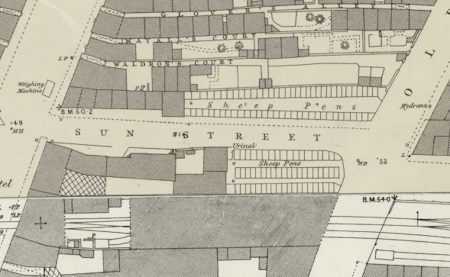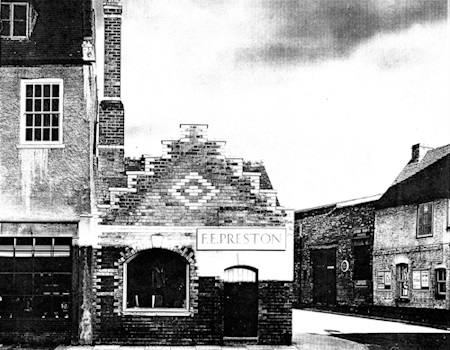The Sun Alley, Inn and Street
to Expand
The new landlord was Dan Kitton. His first announcement was that horses and gigs could be hired from him. He was in the news for shooting a rabid dog which had escaped from the Cross Keys but horses seemed to be his speciality He also worked as a trainer and jockey. In 1954 he was an expert witness in a court case, advising on the costs of keeping horses. Later, he was giving lessons in horse taming, using Mr Rarey’s revolutionary method. In 1859, he quit and sold up. He got into trouble for obstructing a County Court bailiff who was attempting to take possession of fittings from the billiard room. He had paid 20 or 30 children to jeer at him and impede his progress. It gained him nothing more than a 5s fine, though.
When the Inn was put up for sale the whole site was bought by the Borough Council, with the intention of creating a new road. This they did, and Sun Street was born. Confusingly, it was often referred to as Station Street, being almost in line with the street of that name. There was more than enough land for the road. The sheep fair was retained at the Oldbury Road end and the land on the High Street was bought by Joseph Pugh, of the Anchor Inn, who intended building a new Sun Inn. It only got as far as the foundations, though. The discovery of the skeleton of a young woman three feet below the surface seems to have brought the project to an end. Instead, the Borough Council bought the land and erected a row of very distinctive small workshops and offices along the street. The Sun Inn’s spirits licence was transferred to the Albion Inn.
And so things stayed for about a century, until the Bishops Walk development swallowed up the old Sun Street, its sheep fair and little workshops. A new street, still remembering an Inn which was demolished so long ago that we have no image of it, was made further up the High Street.

Sun Street was named for an inn, or maybe more properly a coaching house, of the same name. The pub, demolished in 1859, stood more or less where Greggs now have their shop. It was demolished to create a road to the Oldbury, which was at that time a rapidly growing development area.
There are no known images of the inn but the sale particulars from 1859 give a reasonable picture: It had ‘a carriage drive from the High Street through to the Oldbury Road with a brewhouse, court yards, extensive stabling and coach houses. Also, two cottages adjoining. Also, a valuable piece of land, formerly a garden but recently used as a skittle alley and quoit ground’. This says nothing about the Inn itself, but a description of that comes from an earlier sale, in 1808, which described ‘parlours, dining room, bed chambers, bar, kitchen, brewhouse and domestic offices, with excellent cellaring and stabling’. A substantial coaching inn, occupying a wide burgage plot which included an alley, once called Herbert’s Alley but generally known as Sun Alley, with seven occupied cottages in 1841.
The earliest reference to the Sun Inn was in May 1793 when John Pitt took over an existing business. Later in the year Sergeant Day, of Captain Wall's Independent Company, lodged there whilst hunting down local army deserters.
Charles Dudfield took over from John Pitt in 1809, having previously been landlord of the Fleece Inn, which is now ‘Blow’ Hairdressers. His time at the Sun seemed to be marked by animals abandoned at the inn, especially cows, which he advertised that he would sell to recover his costs if the owners didn’t claim them, and pay the costs. This highlighted the inn’s close association with agriculture and livestock.
Early in 1819, Charles Dudfield sold up and John Insall moved in. He had a bad start, because his wife died in June. Six months later, though, he remarried. In 1837, John died and his son Henry took on the tenancy. Henry started an association with the Ham horse races, and was secretary to the event for several years. The Sun was an official venue for off-course betting. In about 1845, the sheep fair was established at the back of the Inn, entered from Oldbury Road. In 1852 Henry Insall died, at 49 years of age, and 33 years of Insall occupation came to an end.



Comments